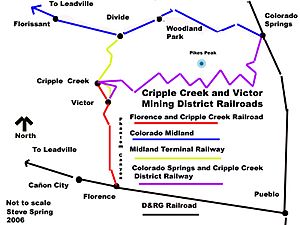Midland Terminal Railway facts for kids
 |
|
| Overview | |
|---|---|
| Headquarters | 21st and Cimarron Streets Colorado Springs, Colorado |
| Reporting mark | MTR (expired) |
| Locale | Colorado |
| Dates of operation | 1893 –1949 |
| Successor | abandoned |
| Technical | |
| Track gauge | 4 ft 8 1⁄2 in (1,435 mm) standard gauge |
| Previous gauge | 3 ft (914 mm) gauge |
The Midland Terminal Railway was a special kind of railroad that helped move things and people. It connected the Colorado Midland Railway near Divide, Colorado to the gold mining town of Cripple Creek, Colorado. This railway stopped running in February 1949.
Contents
The First Railroads in Colorado
From 1887 to 1918, the Colorado Midland Railroad ran trains for 222 miles. Its route went from Colorado City (now Old Colorado City) through Ute Pass. It also crossed the Continental Divide to New Castle, Colorado. This was a town where coal was mined, located west of Glenwood Springs, Colorado.
Building the First Standard Gauge Line
The Colorado Midland was important because it was the first "standard gauge" railroad through the Rocky Mountains. Standard gauge means the tracks were a specific width, making it easier for different trains to use them. Before the Midland Terminal, travelers going to Cripple Creek would get off the train at Divide. From there, they would take a stagecoach to the town. By 1892, people could also travel to Cripple Creek from Canon City. They used the Florence and Cripple Creek Railroad, which had narrower tracks.
How the Midland Terminal Railway Started
In 1890, gold was found in Cripple Creek and Victor. Some owners of the Colorado Midland Railroad decided to build a new line. This new line was called the Midland Terminal Railroad. It was a "spur line," meaning it branched off the main Colorado Midland tracks. This new line went from Divide directly to Cripple Creek.
Connecting Gold Mines to Mills
The Midland Terminal Railway was built with standard gauge tracks. This was a big deal because it made it easy to transfer goods at Divide. It allowed people to travel to and from Cripple Creek. It also helped bring mining equipment into the area. Most importantly, it moved gold ore to processing mills in Colorado City starting in 1895.
The Midland Terminal was the only standard gauge railroad that went into Cripple Creek and Victor. This made it very important for the gold mining industry.
The "Short Line" and Changes
By 1911, another railway called the Colorado Springs and Cripple Creek District Railway was built. It was nicknamed the "Short Line." This railway transported ore from the Cripple Creek mining area directly to processing plants in Old Colorado City. This new route was 11 miles shorter than using the Colorado Midland Railway. It offered both freight (goods) and passenger service. Shipping ore on the Short Line was cheaper than using the Colorado Midland Railway.
In 1917, the Colorado Midland Railway faced financial trouble. A man named Albert E. Carlton bought the company. After this, ore began to be shipped through the Midland Terminal Railway to Old Colorado City. During World War I, the railway faced more challenges. Too many supplies for soldiers were shipped on its lines. The tracks and beds were not built for such heavy use. By August 1918, the Colorado Midland Railway stopped running.
The Midland Terminal Takes Over
In 1919, Albert E. Carlton and Spencer Penrose bought parts of the old Colorado Midland. They bought the terminal buildings in Old Colorado City and the abandoned tracks between Old Colorado City and Divide. The next year, the line through Victor was extended.
The Midland Terminal Railway then carried passengers, mail, and ore from Cripple Creek to Old Colorado City. However, regular passenger service ended in 1931. After 1934, most of the railway's business (90%) was transporting ore. This ore went to the Golden Cycle Mining and Reduction Company. This was the only ore processing plant left in Old Colorado City.
During World War II, some freight and ore were still shipped. But after the war, business slowed down a lot. The railway began to close parts of its track. By 1948, it had abandoned 64.5 miles of track. This included the main line from Old Colorado Springs to Cripple Creek.
What's Left Today
Even though the Midland Terminal Railway stopped running, parts of its history remain.
Buildings and Roads
Some of the old buildings from the Midland Terminal headquarters in Colorado Springs are still used today. For example, the old roundhouse, where trains were turned around, was bought by Van Briggle Pottery in 1955. The machine shop is now the Ghost Town Museum. Also, U.S. Route 24 follows the old railway's path over Ute Pass.
Trails and Tunnels
Today, two miles of the old railway's path are used by the Cripple Creek and Victor Narrow Gauge Railroad. Another part is being turned into a "rail trail." This is a path for walking and biking that connects the Pikes Peak Greenway to Manitou Springs. Parts of the old roadbed and path from Divide to Cripple Creek are now used as Highway 67.
There was an old wooden tunnel from the Midland Terminal that was used as a one-lane highway tunnel on CO 67. In the 1990s, after part of it collapsed, a new road was built around it. The tunnel is still there as a landmark. Its ends are closed with grilles so you can see inside.

